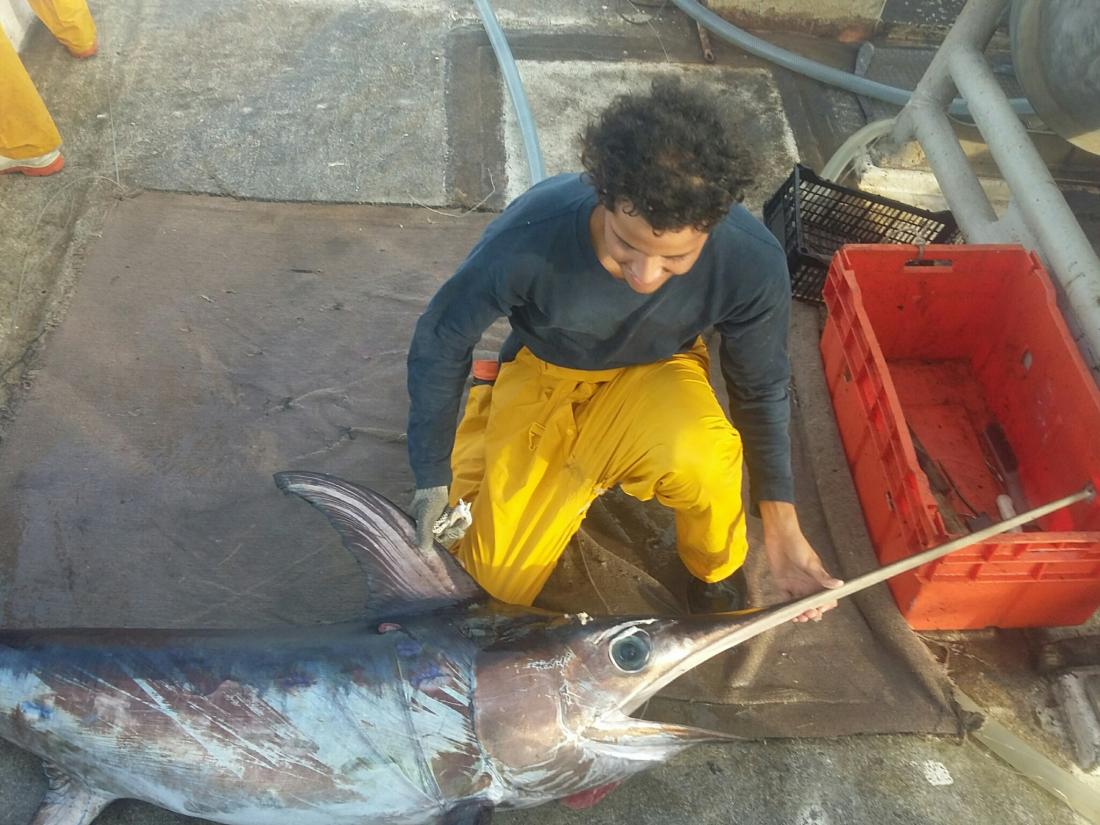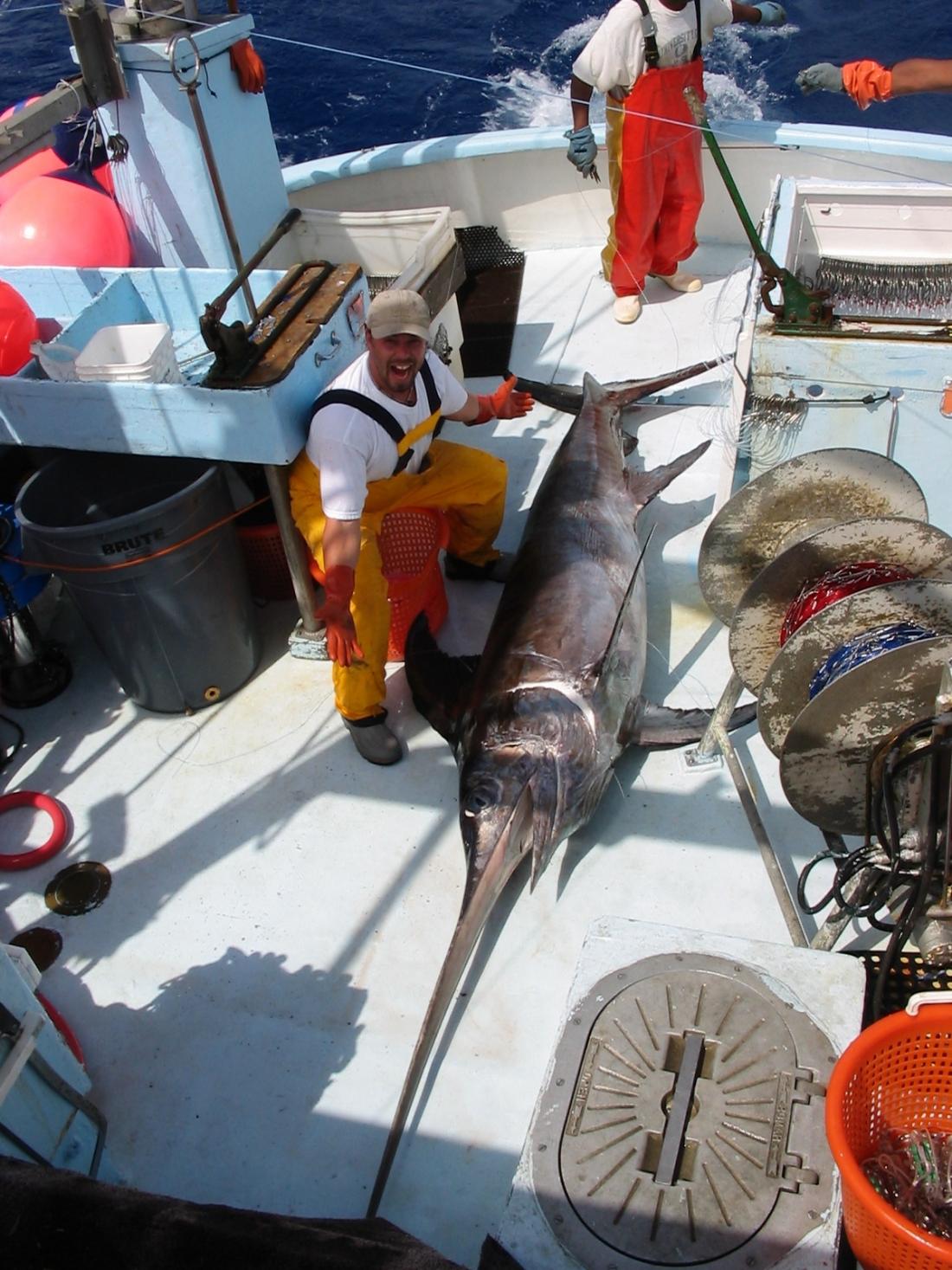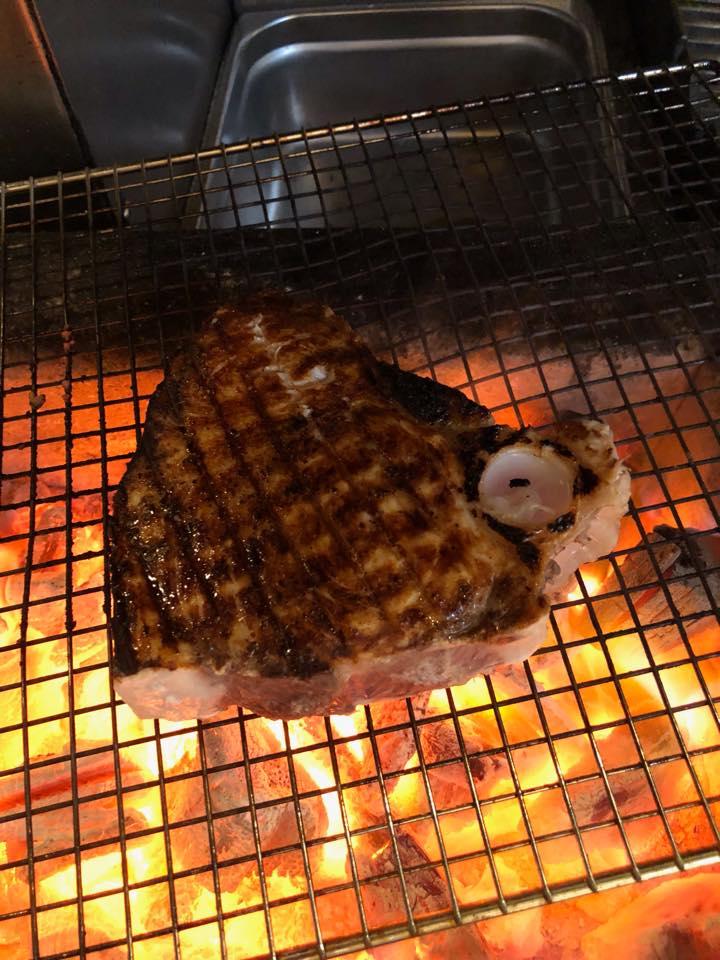Pacific Swordfish
Xiphias gladius
The Science
THE SCIENCE
This fish has iconic, blade-like bills that are flat and edged, as opposed to the smoother, rounded bills seen on marlin. [2]

Taxonomic description
- Distinguishing features include its sword-like bill, no teeth, crescent-shaped dorsal fins, large eys, crescent-shaped tails, and lack of pelvic fins. [1]
- Has a dark-colored back that fades to a light underbelly, and has no scales as an adult. [1]
- Can grow to a maximum length of 4.55 m (14.75 ft) and can weigh a maximum of 650 kg (1,400 lbs). [1]
Distribution
- Highly migratory, and its distribution ranges along the tropical, subtropical, and temperate waters of the globe. [2]
- Particularly abundant along the North Pacific transition zone near Hawaii, along the western coasts of the U.S. and Mexico, and in the Western Pacific, East of Japan. [2]
Life history
- Males live between 9-14 years, and females live for 15-32 years. [3]
- Males reach sexual maturity at 3-4 years old, females mature at 4-5 years old. Spawning occurs throughout the year in equatorial waters and in spring through summer elsewhere. [3]
- Females will release batches of near 16 million eggs that can hatch in 2.5 days if fertilized. The larvae will reach juvenile status at 1 year old. [3]
Habitat
- Pelagic, usually swims alone and inhabits mixed-surface waters with temperatures greater than 15°C (59°F), and can reside shortly in waters as cool as 5°C (41°F). [2]
- Has few predators besides large sharks and large toothed whales, and has historically been used by humans as a food source. [1,3]
The Fishery
THE FISHERY
Swordfish was historically fished by the Chumash indigenous peoples of modern-day Santa Barbara area. [7]

Seaonal availability
- Available year-round, but is highly regulated and subject to fishery closures. [4,5]
Regulatory and managing authority
-
Ranges across international boundaries, and is managed internationally by the Inter-American Tropical Tuna Commission (IATTC) and the Western and Central Pacific Fisheries Commission (WCPFC). The International Scientific Committee for Tuna and Tuna-like Species in the North Pacific Ocean (ISC) collects data on this fishery. [9]
-
Along the Pacific West Coast, this fish is managed by NOAA fisheries and the Pacific Fishery Management Council (established by the Magnuson-Stevens Act) through the West Coast Highly Migratory Species Fisheries Management Plan. [9]
-
As established by the Marine Life Management Act, the California Department of Fish and Wildlife collects helps manage this fishery through the Pelagic Fisheries and Ecosystems Program. [16,17]
Gear type
- Caught commercially by drift gillnet, harpoon, and longline. [3]
- Currently, a new type of gear known as deep-set buoy gear is being explored as an alternative to drift gillnets. [6]
Status of the fishery
- The fishery status in the Pacific is uncertain, but Pacific stocks are currently assumed to be healthy and are being fished at levels below maximum sustained yield. [4]
- Longline fishing is prohibited within 200 miles of the west coast and certain areas alogn the Pacific Islands where Hawaiian monk seals reside. [4]
- Drift gillnets are allowed in federal waters but not state waters. In 2020, a hard cap rule for bycatch was passed for drift gillnet fisheries in California and Oregon. [4,5]
- Circle hooks and fin-fish bait is required to minimize catching sea turtles in Hawaiian longline operations. [4]
Potential ecosystem impacts
- Gillnets and pelagic longlines have high levels of bycatch with sea turtles, sharks, seabirds, and marine mammals. Bycatch is strictly regulated in the U.S., but bycatch may be a greater problem in countries without bycatch mitigation laws. [3]
- Harpoon and hook and line fisheries have low bycatch and almost no impact on the ecosystem. [3]
The Seafood
THE SEAFOOD
Swordfish is a good source of selenium, niacin, vitamin B12, and zinc! [9]


Edible portions
- Typically only the meat is consumed. [10]
Description of meat
- When raw, the meat ranges in color from white and ivory to pink and orange, and turns beige when cooked. It is firm and has a high oil content. [9]
Culinary uses
- Swordfish is typially baked, broiled, grilled, sautéed, or smoked. [10]
- For a grilled swordfish recipe, visit The Mediterranean Fish. [11]
- For a pan roasted swordfish recipe, visit MasterClass. [18]
Nutritional information
- Nutritional information for 100g of cooked swordfish can be found on the table to the right. [8]
Toxicity report
- Swordfish has higher levels of methyl-mercury, so it is not recommended for pregnant women and young children. [10]
Seasonal availability
- Available year-round. [9]
References
[1] Gardieff, S. n.d. Discover fishes: Xiphias gladius. Florida Museum. Web. https://www.floridamuseum.ufl.edu/discover-fish/species-profiles/xiphia…. Accessed 14 July 2020.
[2] NOAA Fisheries. n.d. Swordfish Research. Southwest Fisheries Science Center. Web. https://swfsc.noaa.gov/textblock.aspx?Division=FRD&ParentMenuId=141&id=…. Accessed 14 July 2020.
[3] Ocean Protection Council. n.d. Swordfish (Xiphias gladius). Web. http://opc.ca.gov/webmaster/ftp/project_pages/Rapid%20Assessments/Sword…. Accessed 14 July 2020.
[4] NOAA Fisheries. n.d. North Pacific Swordfish. Web. https://www.fisheries.noaa.gov/species/north-pacific-swordfish#:~:text=….. Accesed 15 July 2020.
[5] NOAA. 2020. Fisheries off West Coast States; Highly Migratory Fisheries; California Drift Gillnet Fishery; Protected Species Hard Caps for the California/Oregon Large-Mesh Drift Gillnet Fishery. Web. https://www.federalregister.gov/documents/2020/02/07/2020-02458/fisheri…. Accessed 15 July 2020.
[6] Roth, A. 2018. Reinventing California's swordfish fishery. UC Santa Cruz science notes. Web. https://ucscsciencenotes.com/feature/reinventing-californias-swordfish-…. Accessed 15 July 2020.
[7] Rick, T., Harvey, V.L., Buckley, M. 2019. Collagen fingerprinting and the Chumash billfish fishery, Santa Barbara Channel, California, USA. Archaeological and Anthropological Sciences 11. pp. 6639-6648. https://doi.org/10.1007/s12520-019-00930-4
[8] Self. n.d. Fish, swordfish, cooked, dry heat. NutritionData. Web. https://nutritiondata.self.com/facts/finfish-and-shellfish-products/413…. Accessed 20 July 2020.
[9] Fishwatch. 2019. North Pacific Swordfish. Web. https://www.fishwatch.gov/profiles/north-pacific-swordfish. Accessed 24 July 2020.
[10] Chef's Resources. n.d. Swordfish Flavor Profile. Web. https://www.chefs-resources.com/seafood/finfish/swordfish/#:~:text=Swor…. Accessed 24 July 2020.
[11] Suzy. 2020. Grilled Swordfish Recipe with a Mediterranean Twist. The Mediterranean Dish. Web. https://www.themediterraneandish.com/grilled-swordfish-recipe/. Accessed 24 July 2020.
[12] Joe Fish Flynn. n.d. Catching a Swordfish. Digital image. Web. https://www.shutterstock.com/image-photo/catching-swordfish-464482394. Accessed 23 December 2020.
[13] Delgadillo Resendiz, H. iNaturalist. 2016. Digital image. Web. https://www.inaturalist.org/photos/60905949. Accessed 24 February 2021.
[14] Snodgrass, D. 2010. Photo of fisherman posing with swordfish. Wikipedia. Digital image. Web. https://commons.wikimedia.org/wiki/File:Xiphias_gladius.jpg. Accessed 24 July 2020.
[15] Tuna Harbor Dockside Market. Facebook. 2018. Digital image. Web. https://www.facebook.com/thdocksidemarket/photos/2333452533350683. Accessed 23 February 2021.
[16] Marine Life Management Act. n.d. California Department of Fish and Wildlife. Web. https://wildlife.ca.gov/Conservation/Marine/MLMA. Accessed 24 August 2020.
[17] Overview of the Pelagic Fisheries and Ecosystems Program. n.d. California Department of Fish and Wildlife. Web. https://wildlife.ca.gov/Conservation/Marine/Pelagic#52132542-overview. Accessed 9 December 2020.
[18] MasterClass. 2020. How to Cook Swordfish: Quick and Easy Pan-Roasted Swordfish Recipe. Web. https://www.masterclass.com/articles/how-to-cook-swordfish-quick-and-ea…. Accessed 29 January 2021.



